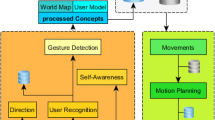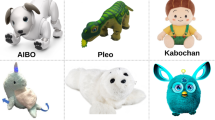Abstract
Recently, there has been an increasing interest in the adoption of socially assistive robots to support and alleviate the workload of clinical personnel in hospital settings. This work proposes the adoption of a socially assistive robot in Intensive Care Units to evaluate the criticality scores of bedridden patients. Within this scenario, the human gaze represents a key clinical cue for assessing a patient’s conscious state. In this work, a user study involving 10 participants role-playing 4 levels of consciousness is performed. The collected videos were manually annotated considering 6 gazing directions and an open-source automatic tool was used to extract head pose and eye gazing features. Different feature sets and classification models were compared to find the most appropriate configuration to detect user gaze in this scenario. Results have suggested that the most accurate gazing estimation is obtained when the head pose information is combined with the eye orientation (0.85). Additionally, the framework proposed in this study seems to be user-independent, thereby encouraging the deployment of appropriate robotic solutions in real assistive contexts.
Access this chapter
Tax calculation will be finalised at checkout
Purchases are for personal use only
Similar content being viewed by others
References
Kabacińska, K., Prescott, T.J., Robillard, J.M. : Socially assistive robots as mental health interventions for children: a scoping review. Int. J. Soc. Robot. 13, (2021). https://doi.org/10.1007/s12369-020-00679-0
Bemelmans, R., Gelderblom, G.J., Jonker, P., de Witte, L.: Socially assistive robots in elderly care. : A Syst. Rev. into Eff. effectiveness (2012). https://doi.org/10.1016/j.jamda.2010.10.002
Scassellati, B., Vázquez, M.: The potential of socially assistive robots during infectious disease outbreaks (2020). https://doi.org/10.1126/scirobotics.abc9014
Chang, W.H., Kim, Y.-H.: Robot-assisted therapy in stroke rehabilitation. J. Stroke 15(3), 174 (2013). https://doi.org/10.5853/jos.2013.15.3.174
Rodriguez-Gonzalez, C.G., Herranz-Alonso, A., Escudero-Vilaplana, V., Ais-Larisgoitia, M.A., Iglesias-Peinado, I., Sanjurjo-Saez, M.: Robotic dispensing improves patient safety, inventory management, and staff satisfaction in an outpatient hospital pharmacy. J. Eval. Clin. Pract. 25, (2019). 10.1111/jep.13014.https://doi.org/10.1111/jep.13014
Jeffcock, J., Hansen, M., Garate, V.R.: Transformers and human-robot interaction for delirium detection. In: ACM/IEEE International Conference on Human-Robot Interaction (2023). https://doi.org/10.1145/3568162.3576971
Teng, R., Ding, Y., See, K.C.: Use of robots in critical care. Syst. Rev. (2022). https://doi.org/10.2196/33380
Ghosh, S., Dhall, A., Hayat, M., Knibbe, J., Ji, Q.: Automatic gaze analysis: a survey of deep learning based approaches. 1–24 (2021)
Admoni, H., Scassellati, B.: Social eye gaze in human-robot interaction: a review. J. Hum-Robot Interac 6(1), 25 (2017). https://doi.org/10.5898/JHRI.6.1.Admoni
Wachowiak, L., Tisnikar, P., Canal, G., Coles, A., Leonetti, M., Celiktutan, O.: Analysing eye gaze patterns during confusion and errors in human-agent collaborations. In: RO-MAN 2022 - 31st IEEE International Conference on Robot and Human Interactive Communication: Social, Asocial, and Antisocial Robots (2022). https://doi.org/10.1109/RO-MAN53752.2022.9900589
Zhang, X., Sugano, Y., Fritz, M., Bulling, A.: Appearance-based gaze estimation in the wild. In: Proceedings of the IEEE Computer Society Conference on Computer Vision and Pattern Recognition (2015). https://doi.org/10.1109/CVPR.2015.7299081
Fischer, T., Chang, H.J., Demiris, Y.: RT-GENE: Real-time eye gaze estimation in natural environments. In: Lecture Notes in Computer Science (including subseries Lecture Notes in Artificial Intelligence and Lecture Notes in Bioinformatics) (2018)https://doi.org/10.1007/978-3-030-01249-6_21
Kellnhofer, P., Recasens, A., Stent, S., Matusik, W., Torralba, A.: Gaze360: physically unconstrained gaze estimation in the wild. In: Proceedings of the IEEE International Conference on Computer Vision (2019). https://doi.org/10.1109/ICCV.2019.00701
Romanelli, D., Mw, F.: AVPU Score. In: StatPearls (2020)
Jones, C.: Glascow Coma Scale. Am. J. Nurs. (1979)
Baur, T., Heimerl, A., Lingenfelser, F., Wagner, J., Valstar, M.F., Schuller, B., André, E.: Explainable cooperative machine learning with NOVA. KI - Künstliche Intelligenz 34(2), 143–164 (2020). https://doi.org/10.1007/s13218-020-00632-3
Patacchiola, M., Cangelosi, A.: Head pose estimation in the wild using convolutional neural networks and adaptive gradient methods. Pattern Recogn. 71, 132–143 (2017). https://doi.org/10.1016/j.patcog.2017.06.009
Palinko, O., Rea, F., Sandini, G., Sciutti, A.: A robot reading human gaze: why eye tracking is better than head tracking for human-robot collaboration. In: IEEE International Conference on Intelligent Robots and Systems (2016). https://doi.org/10.1109/IROS.2016.7759741
Acknowledgements
This work has been partially supported by European Union - Next Generation EU under Project: “A novel public-private alliance to generate socioeconomic, biomedical and technological solutions for an inclusive Italian ageing society” (Age-IT), CUP: B83C22004800006 and by Piano Nazionale per gli Investimenti Complementari PNC-PNRR Fit for Medical Robotics (Fit4MedRob), CUP: B53C22006950001.
Author information
Authors and Affiliations
Corresponding author
Editor information
Editors and Affiliations
Rights and permissions
Copyright information
© 2024 The Author(s), under exclusive license to Springer Nature Singapore Pte Ltd.
About this paper
Cite this paper
Sorrentino, A. et al. (2024). Feasibility Study on Eye Gazing in Socially Assistive Robotics: An Intensive Care Unit Scenario. In: Ali, A.A., et al. Social Robotics. ICSR 2023. Lecture Notes in Computer Science(), vol 14453 . Springer, Singapore. https://doi.org/10.1007/978-981-99-8715-3_5
Download citation
DOI: https://doi.org/10.1007/978-981-99-8715-3_5
Published:
Publisher Name: Springer, Singapore
Print ISBN: 978-981-99-8714-6
Online ISBN: 978-981-99-8715-3
eBook Packages: Computer ScienceComputer Science (R0)




